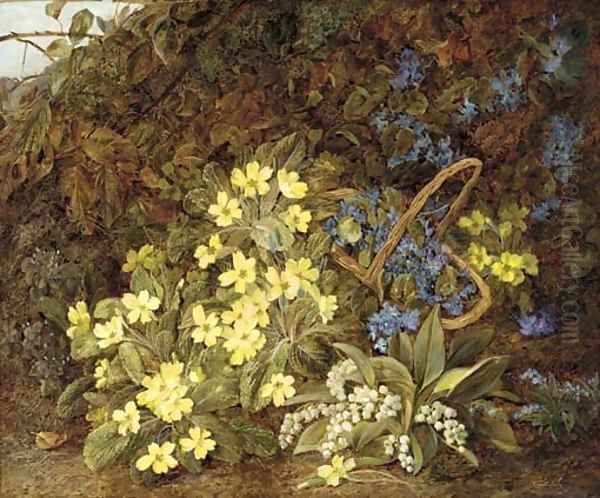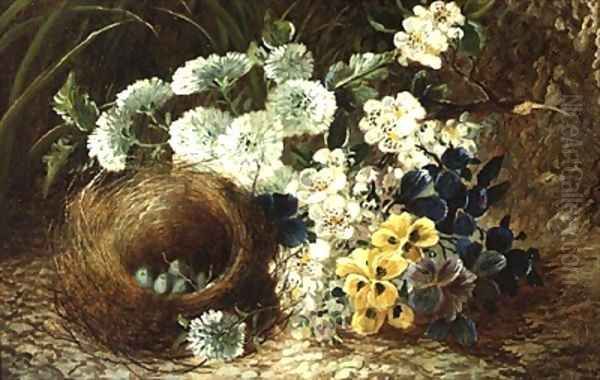Vincent Clare, an artist whose life spanned from 1855 to 1930, holds a distinct place in the annals of British art. He was a painter renowned primarily for his exquisite still life compositions, specializing in the delicate and detailed rendering of fruits and flowers. Operating within the rich artistic milieu of late Victorian and Edwardian England, Clare carved out a niche for himself, continuing a tradition of meticulous observation and technical proficiency that appealed greatly to the tastes of the era. Born into an artistic family, his work reflects both inherited skill and a personal dedication to capturing the transient beauty of the natural world.
A Birmingham Artist and a Family Tradition
Vincent Clare was born in Birmingham, England, in 1855. This industrial city, perhaps surprisingly, nurtured a vibrant artistic community, and the Clare family was central to it, particularly in the realm of still life painting. Vincent was not the only artist in his family; he was the son of George Clare (c.1835-1900) and the brother of Oliver Clare (1853-1927), both of whom were accomplished painters in their own right, specializing in similar subject matter. This familial connection undoubtedly played a significant role in shaping Vincent's artistic path.
The influence of George Clare on his sons, Vincent and Oliver, is particularly noteworthy. George Clare was known for his highly detailed technique, often described as employing a form of "stippling." This method involves using small dots or short brushstrokes to build up form and texture, allowing for an incredibly fine level of detail. It is believed George Clare himself drew inspiration from the work of earlier British artists like William Henry Hunt (1790-1864), a watercolourist celebrated for his minutely observed still lifes, particularly bird's nests and fruit.
Vincent Clare clearly inherited and adapted this meticulous approach. His paintings demonstrate a profound focus on detail, a careful handling of paint, and a deep appreciation for the textures, colours, and forms found in nature. Working alongside his father and brother likely provided both training and a shared artistic language centered on the faithful representation of the natural world.
Artistic Style: Capturing Nature's Details

Vincent Clare's artistic output is dominated by still life paintings. His favoured subjects were arrangements of fruit – grapes, peaches, strawberries, plums – often depicted spilling from baskets or arranged invitingly on mossy banks. Floral subjects were equally important, with depictions of flowers, both cultivated and wild, rendered with botanical accuracy and aesthetic sensitivity. A recurring motif in the work of the Clare family, including Vincent, was the inclusion of bird's nests, often nestled amongst the flowers or foliage, adding a touch of poignant, naturalistic detail.
The defining characteristic of Clare's style is its meticulous realism. He employed fine, precise brushwork to capture the bloom on a grape, the fuzzy skin of a peach, the delicate veining of a petal, or the intricate construction of a bird's nest. His technique allowed him to render textures convincingly – the coolness of dew on leaves, the softness of moss, the smoothness of an eggshell. Light plays a subtle but crucial role in his compositions, highlighting the forms and adding depth without dramatic chiaroscuro.
His compositions are typically intimate in scale and focus. Often set against dark or naturalistic backgrounds, such as earthy banks or simple ledges, the arrangements themselves become the undisputed focal point. This approach aligns with the Victorian appreciation for detailed observation and the celebration of nature's bounty and intricacy. While continental Europe was witnessing the revolutionary experiments of Impressionism and Post-Impressionism, artists like Vincent Clare continued a distinctly British tradition of detailed naturalism.
Representative Works and Themes
While a comprehensive catalogue raisonné might be elusive, several titles and descriptions give us insight into Vincent Clare's typical output. Works such as "Lilies Of The Valley" point to his focus on specific floral subjects, likely depicted with the characteristic delicacy associated with his style. The title "Birds Nest" (or variations like "Still Life of Flowers on a Mossy Bank with a Bird's Nest") confirms his engagement with this popular Victorian motif, often symbolizing domesticity, nature's fragility, and the cycle of life.
Auction records provide further examples, such as "Still Life: Fruit, Grapes, Peach and Strawberries." This title clearly indicates his proficiency in rendering fruit compositions, a staple of his oeuvre. These works often showcase a variety of fruits, allowing the artist to display his skill in capturing different shapes, colours, and textures within a single harmonious arrangement. The settings, often described as "mossy banks," provide a naturalistic context that enhances the realism and charm of the depicted objects. Whether working in oil on canvas or occasionally in watercolour, the emphasis remained on careful execution and fidelity to the subject.
Exhibition, Recognition, and Market Presence

Vincent Clare's work found an appreciative audience during his lifetime and continues to be collected today. Evidence suggests his paintings were exhibited, with mentions of works appearing at venues like the Southgate Gallery. This indicates a degree of professional recognition within the British art world of his time. While perhaps not achieving the widespread fame of leading Royal Academicians like Lord Leighton (Frederic Leighton, 1830-1896) or members of the Pre-Raphaelite Brotherhood such as Dante Gabriel Rossetti (1828-1882) or John Everett Millais (1829-1896), Clare occupied a respected position within his specific genre.
In the contemporary art market, Vincent Clare's paintings appear regularly at auction. His works are generally accessibly priced, often selling for sums ranging from several hundred to a few thousand British pounds, depending on size, condition, subject matter, and provenance. For instance, oil paintings featuring fruit arrangements might fetch prices around £800-£1000, while watercolours or smaller pieces might be estimated at £350-£450, as seen in recent sales records.
This market position makes his work attractive to collectors specializing in Victorian art, still life painting, or artists from the Birmingham school. The consistent quality, charming subject matter, and the legacy of the Clare family name contribute to his enduring appeal. His paintings offer a tangible connection to the aesthetic sensibilities of the late 19th and early 20th centuries.
Contextualizing Clare in Art History
Vincent Clare worked during a period of immense artistic change across Europe. While he maintained his focus on detailed still life, the art world beyond Britain was being transformed. In France, Impressionists like Claude Monet (1840-1926), Pierre-Auguste Renoir (1841-1919), Edgar Degas (1834-1917), and Camille Pissarro (1830-1903) had revolutionized painting with their focus on light, colour, and capturing fleeting moments, often painting en plein air.
Following them, Post-Impressionists pushed artistic boundaries even further. Vincent van Gogh (1853-1890), a Dutch contemporary of Clare (though vastly different in style and life trajectory), used expressive colour and brushwork to convey intense emotion. Paul Gauguin (1848-1903) explored symbolism and bold, flat areas of colour, while Georges Seurat (1859-1891) developed Pointillism, a technique based on optical mixing of colours. Even earlier, Realists like Gustave Courbet (1819-1877) had challenged academic conventions by depicting scenes of everyday life with unvarnished honesty.
Against this backdrop of radical innovation, Vincent Clare's work represents a continuation of a more traditional, albeit highly skilled, approach to painting. His dedication to meticulous representation and naturalistic detail places him firmly within a lineage of British still life and nature painters, tracing back through his father George Clare and influences like William Henry Hunt. His art offers a quieter, more intimate vision, focused on the enduring beauty found in the careful observation of humble, natural objects.
Later Life and Legacy

Details regarding Vincent Clare's later life are less documented than his artistic output. However, records indicate that he passed away in 1930. Significantly, his place of death is recorded not in his native Birmingham, but in Ardagh, near Ballina in County Mayo, Ireland. The reasons for his presence in Ireland later in life are not immediately clear from the available art historical sources, adding an element of quiet mystery to the end of his biography.
Vincent Clare's legacy resides in his contribution to the genre of still life painting in Britain. As part of the Clare family dynasty of artists, he helped perpetuate a style characterized by intricate detail, delicate rendering, and a deep appreciation for nature. His paintings, particularly those featuring fruit and flowers on mossy banks, remain quintessential examples of late Victorian and Edwardian taste. They stand as charming, highly skilled representations of a specific artistic tradition, offering a contrast to the more turbulent artistic currents developing elsewhere in Europe. His work continues to be admired and collected for its technical accomplishment and its gentle, enduring celebration of the natural world.